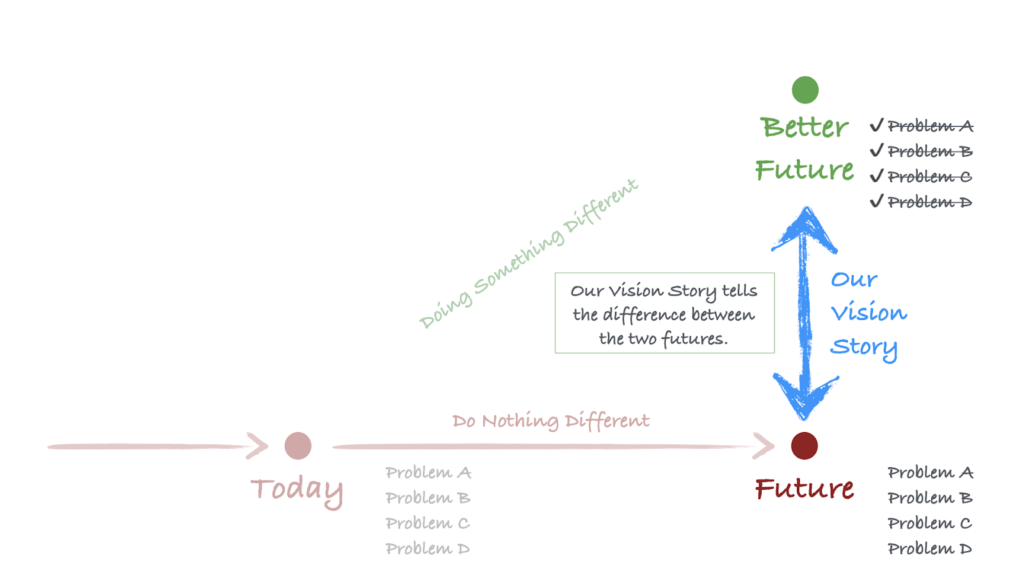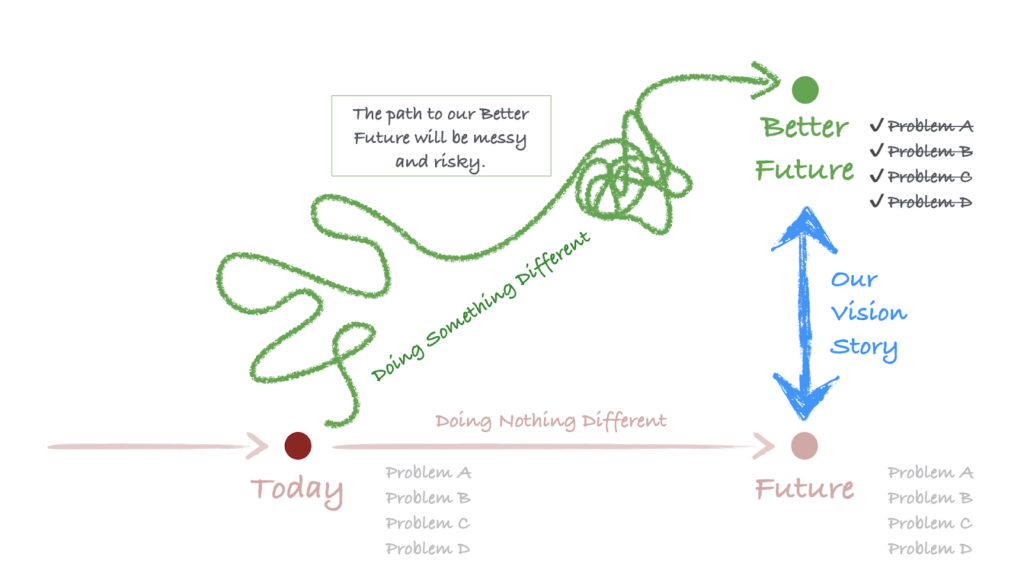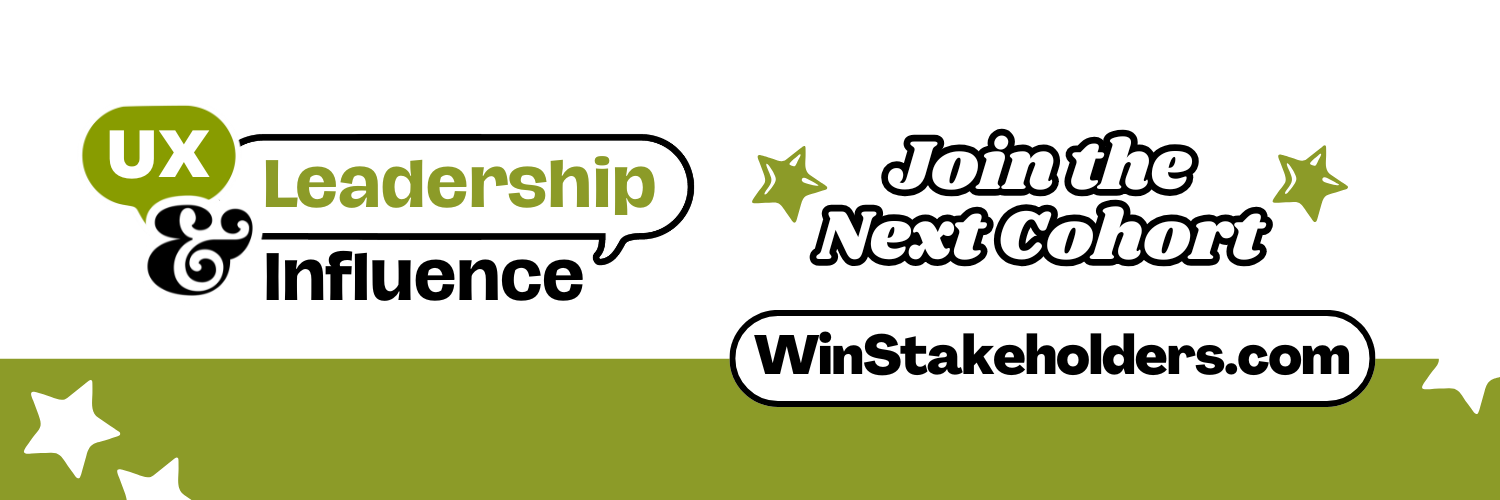The Diagram that Shows Where A Vision Comes From

Vision — It’s a word we throw around a lot.
“What’s your vision for this work?”
“Here’s my vision for the product.”
“We need a vision for how things should work around here.”
When we work, we crave a clear and definitive vision—a view into the future excites us. We love it when we understand that what we’re working on right now is a small piece of a much bigger thing yet to come.
A compelling vision motivates us to do our best work every day.
Without a clear vision, we feel lost. It’s as if today’s work has no final destination, no point for existing. We’re just going through the motions to deliver something, and it doesn’t matter what it is.
The vision must come from… You.
The vision feels like some giant, highfalutin thing that is supposed to come from someone at the top of the organization. But that’s not the case.
Where do visions come from? A vision is a meaningful change we must communicate to others, usually because we need their help to make it happen. We want the vision to show us how our work today will contribute to this vital change.
Anyone can have a vision of the future, including you. You’re the right person to create the vision because nobody else sees the necessary change you’re seeing. (If they had, they’d already start changing it.)
Like many things, it’s easier to understand all this when you see a diagram. Below is my diagram of what a vision is and how you use it to inspire people to make necessary changes.
Starting with the timeline we’re on.
The full diagram can be difficult to understand, so I’ve learned the best way to explain it is to build it step by step. So, that’s what we’ll do here…

Start with the timeline you’re currently on. Draw a line that represents everything that has happened up to today, the moment that represents today, and the timeline that extends to a moment in the future.

Now, we can see that there are blatant problems today. (If there weren’t problems, we wouldn’t need to change anything, and we wouldn’t need a vision.)
The problems are a list of changes we’d like to see. They could be problems with the product we’re working on or how we build and deliver products. These problems could affect our customers, users, or fellow employees.
It doesn’t matter what the problems are. It only matters that we can see and want to resolve them.
If they were easy problems, we’d have solved them already. Therefore, the problems we describe in the vision typically require time to address and people to help.

Next, add that the line beyond today is the timeline where we do nothing differently. We will keep doing what we’ve always done.
Without a vision to guide us, we’re not doing anything differently, and the problems we can see today won’t disappear. The problems will still be here because we aren’t taking any new actions to resolve them. Remember, we’re doing the same things we’ve always done.
Nothing will change because we’re not making any changes. Instead, things will likely get worse because that’s how entropy works. There will be a few new problems because our current way of doing things doesn’t solve problems; it only makes them.
A timeline that leads to a Better Future.

That’s not our only possible future. There’s another future — a Better Future.
When we imagine this better future, we picture that we’ve solved each of today’s problems. Somehow, we figured out how to solve them on the way to this future.

To solve each problem, we must do something different from what we’ve done before. However, we don’t immediately need to identify what we’ll do differently.
Instead, we must first sell people on the Better Future. The people whose help we need — our teammates, peers in other teams, and maybe even stakeholders and executives — must see this Better Future as we do. They must know how this Better Future is far improved over the future we get when we do nothing differently.
They’ll not buy into doing anything differently if they don’t see any improvement between the Better Future and our default alternative—the one we’re destined to achieve when we don’t take action. The change required is probably complicated and risky, but in their mind, the benefits must outweigh the complexity and risk.

That’s where our vision comes in. The vision is a story we tell that describes the difference between two futures: the one we’ll get to if we don’t do anything differently and the Better Future we’re imagining.
Our vision story describes the problems we see today and explains why they won’t disappear on their own. It also describes how much better things will be because we’ve solved each of today’s problems.

We must sell our vision followers — those teammates, peers, stakeholders, and executives from whom we’ll need help — on the Better Future before discussing what we all need to do differently. Transitioning from today to our Better Future will not be easy.
It’s likely a messy adventure to get to our Better Future because we’ve never done it. We’ll take erroneous turns. We’ll get lost on the way, probably a couple of times. We are sure to get stuck. (If it were easy, we’d have done it already.)
It’s so messy that nobody would sign up to go on this adventure without seeing a clear benefit at the end. That’s why we don’t talk about it upfront. We don’t even talk about how long it’ll take, except in the vaguest of terms.
Instead, we only focus on our Better Future in our Vision Story. If someone asks how we’ll get there, we can answer with a vague, “I don’t know yet, but I have some ideas.” (We can also add, “If you have ideas, I’d love to hear them.” to signal that we’ll go on this adventure together.)
If someone asks about the time frame, we can answer vaguely, “I was thinking it might take years. We’ll do it in baby steps, learning as we go. We’ll figure all this out once we agree this is the future we want. No sense spending time planning for something we don’t want.”

That’s it. That’s how you can describe where an organizational vision comes from. It comes from imagining a Better Future based on the problems you’re seeing today. You use an imagined Better Future to tell why the change is essential and why others should join in and support our vision.
Describe your vision.
The elements of this diagram serve as a valuable framework for describing your vision for a Better Future. Whether you’re presenting or writing a proposal, you can use the diagram to introduce your ideas.
You can use the same approach we used to build the diagram. Lay out your vision for the people you want to join this adventure. You just need a few details.

Start with the problems you see today. You can’t assume others see them like we do, so we have to show them clearly.
There are some questions you can ask to get you the details you need:
- What do each of the problems look like when they occur?
- How is it different from each of these problems don’t occur?
- Which individuals (customers, users, employees, or others) are currently harmed by each problem, and what is that harm like for them?
- How does each problem currently harm our organization?
- How is it made worse when these problems all coincide?

- If we do nothing different, which problems will still be here?
- Which problems will get worse and how?
![Diagram shows the Better Future point with the four problems checked off and crossed out. It lists the three questions from the article.]](https://articles.centercentre.com/wp-content/uploads/2024/08/12-1024x221.png)
- How does each problem get resolved in our Better Future?
- How do the individuals we talked about earlier see improvements because we’ve fixed each problem?
- How do these improvements help the organization achieve its overall objectives?
That’s all there is to it. Ten simple questions get you to a solid vision presentation that could solve the most frustrating problems of the day.
Well, not quite. There’s one more thing:
Your vision needs to be compelling. You can’t just describe any set of changes. Your vision needs big problems and a dramatically Better Future.
They must see this as an imperative to inspire the folks you need to help you. That’s where the skill comes in.
Anyone can describe a set of problems and their fixes. However, a skilled leader must rally the organization around a set of changes that will have massive significance.
The good news is that anyone can learn and master those leadership skills, including you. And, if you don’t do it, who will?
So, what big problems do you want to see disappear when you achieve your Better Future? That’s your vision!
UX Leadership and Influence program
(Formerly called the How to Win Stakeholders & Influence Decisions program.)

Our 16-Week program guides you step-by-step in selling your toughest stakeholders on the value
of UX
research and design.
Win over the hardest of the hard-to-convince stakeholders in your organization. Get teams to
adopt a
user-centered approach. Gain traction by doing your best UX work.
Join us to influence meaningful improvements in your organization’s products and services.
Learn more about our UX Leadership and Influence program today!

